
The wonderful thing about Victoria is that, except for the mountain wilderness in the state’s east, you’re never far from civilisation. By the same token, though, you needn’t travel far out of Melbourne to reach a charming country town or pass through picturesque farmland. Victoria also offers variety – everything from alpine ski resorts to coastal havens to red-dirt outback towns and wine country – and it’s usually no more than a few hours’ drive from place to place.
Below are Open Road’s top five Victorian road trips. If one of them spurs you into action, don’t forget to use the Trip Planner to make the most of your My NRMA Rewards membership!
The eastern section of the Victorian coastline between the NSW border and the town of Orbost passes through a lot of remote country, and you’ll need to make side trips to explore what the coastal towns have to offer.
Mallacoota describes itself as “East Gippsland’s best kept secret” and it’s hard to argue, with fishing and water sports on the Wallagaraugh River, pristine beaches out past Bastion Point, and access to the vast wilderness of Croajingolong National Park. Nature and history buffs will want to arrange a day tour to Gabo Island to check out the 19th century lighthouse and witness the daily pilgrimage of little penguins to and from the ocean.
Cann River is an ideal stopover point. This small and remote town situated on the Princes Highway offers a handful of eateries and places to stay, an historic pub, and loads of outdoor activities including fishing, bushwalking and four-wheel driving.
Orbost is the first real taste of urban life beyond the NSW border and a good base for a day’s drive down to Marlo – a tiny locale with a hotel, a general store and not much else. But it does have a very Aussie claim to fame: it’s where the Snowy River meets the Tasman Sea after flowing 352km from Mount Stillwell in NSW. There are loads of vantage points along Marlo-Conran Road where you can get a snap of the Snowy’s zig-zagging mouth.
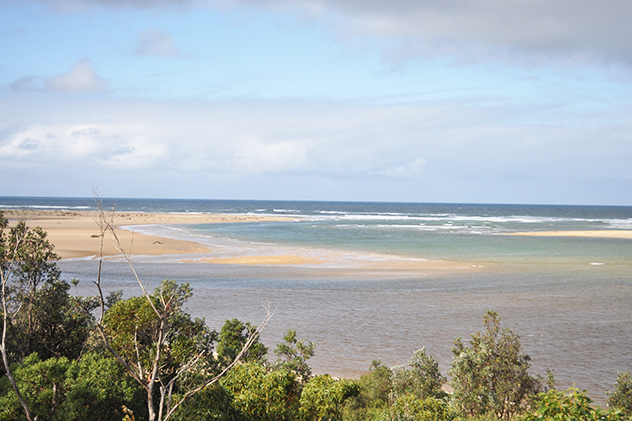
The Snowy River flowing into the Bass Strait near Marlo in Victoria, Australia.
Continuing along the Princes Highway brings you to one of Victoria’s most famous coastal holiday hotspots, Lakes Entrance, and the cluster of towns around the regional hub of Sale. If you don’t mind a short detour, the d-shaped loop created between Longford, Loch Sport, and The Honeysuckles offers a scenic drive with plenty to stop and see along the way, including the remnants of the iron-hulled Trinculo on Golden Beach, wrecked during a storm over a century ago.
A natural terminus for an exploration of Victoria’s east coast is Wilsons Promontory, known locally as ‘Wilsons Prom’ or just ‘The Prom’. This untamed peninsula is perfect for campers and bushwalkers, while those of a sun ’n’ surf persuasion will find heaven on the aptly named Squeaky Beach (its quartz sand squeaks as you walk on it). Spectacular snorkelling and diving opportunities also await in The Prom’s marine national park.
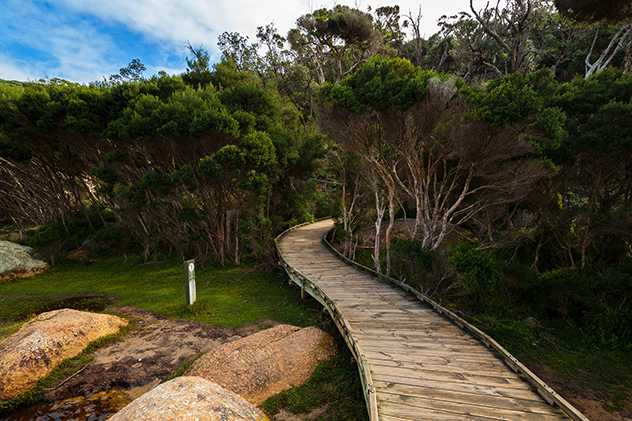
Boardwalk and bridge crossing Tidal River at Wilsons Promontory National Park.
This is arguably Australia’s most famous road trip and deserves its notoriety – although these days it’s best to consider going ‘out of season’, as it attracts huge crowds at key sites in the warmer months.
The official gateway to The Great Ocean Road is Torquay. We suggest kicking things off with a photo at nearby Bells Beach, which became world-famous as the setting for the finale of Point Break (1991) starring Keanu Reeves and Patrick Swayze. The beach cuts an arc into the coastline, its cobbled cliffs and coarse sand lending it a ruggedly handsome look.
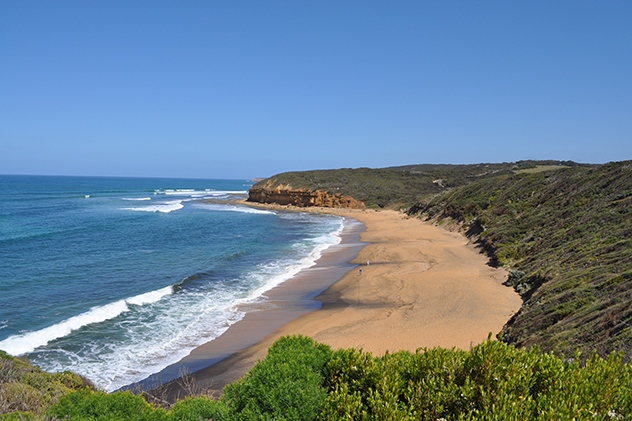
Bells Beach, Victoria.
The Great Ocean Road Chocolaterie & Ice Creamery in Bellbrae opened in 2016 and has become a Great Ocean Road institution. On its shelves are countless chocolate varieties made on site (you can view the factory’s operations through large picture windows), and in addition to this wonderment of confectionery is an attached café, two gelato bars with more than 20 flavours to choose from, and large manicured grounds where you can enjoy your treats while the kids work off their sugar high in the play area.
Between Anglesea and Apollo Bay, the Great Ocean Road lives up to its reputation as one of the world’s great drives. Heading west, the road nuzzles up against the coast and is often no more than ten or twenty metres from the water. On the right, steep hillsides and cragged cliffs loom large, while now and again a crest affords a view of the roadway snaking ahead, a light sea-spray shrouding the hills in the distance.
If you can, it’s worth devoting a day to Apollo Bay, as there’s plenty to see and do. Active and outdoorsy types can take in the foreshore on foot or bicycle, hike the Great Ocean Walk, or venture through Mait’s Rest rainforest. Children will love the native animals at Wildlife Wonders, and history buffs should stop in at the Apollo Bay Museum to brush up on local history. We recommend Apollo Bay Bakery for a sausage roll or pie and a surprisingly good coffee.
Beyond Apollo Bay, the Great Ocean Road squiggles inland through verdant pastures and rainforest. Bathed in golden sunshine, the town of Port Campbell wouldn’t look out of place on an old postcard and it is home to the NRMA Port Campbell Holiday Park.
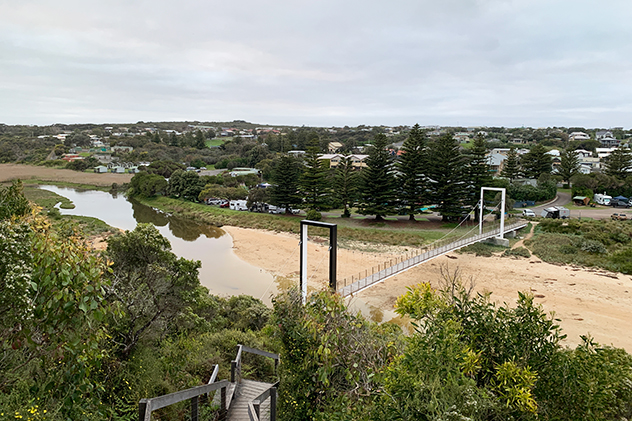
Port Campbell Suspension Bridge, Port Campbell, Victoria.
The town’s distinctive jetty that extends out into the bay was first built in 1880 to allow produce from local farmers to be transported via ship (the roads into the area ranged from ‘rough’ to ‘impassable’ depending on the season). These days Port Campbell is primarily a holiday destination. The town centre feels compact and convenient, with cafés, pubs, a brewery, a distillery, an ice cream shop, a lolly shop, restaurants, and groceries – all in walking distance from the NRMA park.
Port Campbell Bay is a wonderful place for kids to swim when the weather is clement, but if it isn’t, make the short drive into the nearby village of Timboon. It lies at the heart of the 12 Apostles Food Artisans Gourmet Trail, a kind of foodie scavenger hunt gathering everything from ice cream to a strawberry farm and a whiskey distillery.
The Twelve Apostles and Gibson’s Steps are the best known of the numerous rock formations dotted along the coast in this region. Other geological sculptures worth stopping at include Loch Ard Gorge, London Bridge, The Grotto, Bay of Islands and Childers Cove. They’re much quieter than the Twelve Apostles and Gibson’s Steps, yet no less spectacular for that.
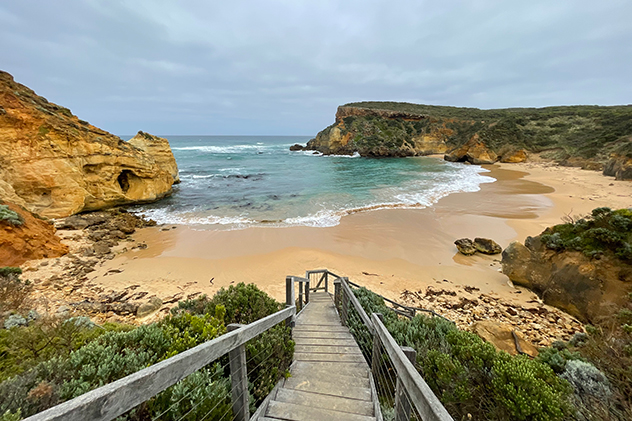
Wooden staircase leading down to the secluded shores of Childers Cove, Victoria.
Once you’ve had your fill of rocks, pause for lunch at Cheese World, a working dairy factory and museum in Allansford that also sports a café serving quality food and coffee.
About a kilometre further along, the Great Ocean Road terminates and merges into the Princes Highway which, although it might not have the Great Ocean Road’s snazzy name, is blessed with pastoral scenery comparable to any in Australia.
We tend to think of Victoria as a ‘tamed’ state, but if you want to know just how rugged and remote it can be, we recommend this south-north hinterland drive. There are plenty of potential starting points around the Lakes Entrance region, which is about a four-hour drive from Melbourne.
This trip commences on the Great Alpine Road, which skiers might know as the route into the popular Mount Hotham resort. Rather than follow it west to the ski fields, however, stop in at the charming town of Omeo. Founded during the gold rush, Omeo is a history buff’s delight with a 19th century courthouse, post office and even a jail constructed of logs. And make sure you pop in at the super-cute cuckoo clock shop.
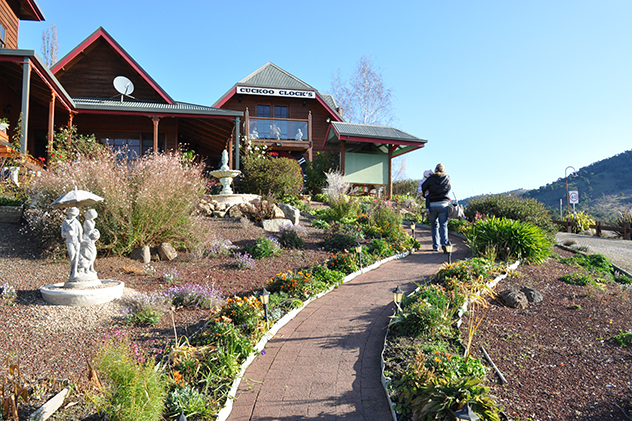
Omeo German Cuckoo Clock Shop, Omeo, Victoria.
Once you’re ready to move on, join the Omeo Highway, a seemingly never-ending succession of curves and switchbacks tailor-made for a sports car. This remains wild and isolated country – the final section of the Omeo Highway was only sealed in 2014!
Anglers Rest is an excellent place for an overnight stay – because there’s literally nothing else except campgrounds for 100km. It’s a throwback to the colonial era, when a town was its pub and the pub was the town. If you approach the Blue Duck Inn in the cooler months (and it can get down to -7ºC in winter!) you’ll see wisps of smoke rising from its chimney. Fashioned from weatherboard and corrugated iron, the Blue Duck overlooks the fast-flowing Cobungra River. Just up the hill is a series of cabins that look rustic on the outside but are spacious and snug on the inside. Be sure to go outside at night for some stargazing, as the Milky Way billows across the pristine sky like a steam cloud.
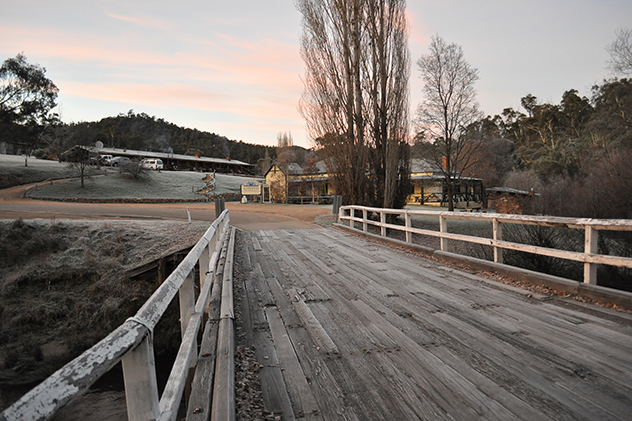
Anglers Rest, Victoria
The 108km between Anglers Rest and Mitta Mitta is dense bushland (there’s not even a petrol station, so make sure you brim your car’s tank on the first day). Though rugged and untamed, this land is spectacular – especially when you reach the summit of a mountain and a break in the trees reveals a vista of sun-drenched valleys below.
Arriving in Mitta Mitta is like stepping out of a jungle and back into civilisation. Mitta Mitta Pub, formerly known as the Laurel Hotel, was made over in 2014 and is now one of country Victoria’s hidden gems. Huge timber beams, stained glass windows, a bartop inlaid with barbed wire, and the front section of a Bedford truck are among the decorating choices that give it a fun and welcoming atmosphere. The rear of the property slopes down to Snowy Creek, which flows past the scenic wooded foothills beyond.
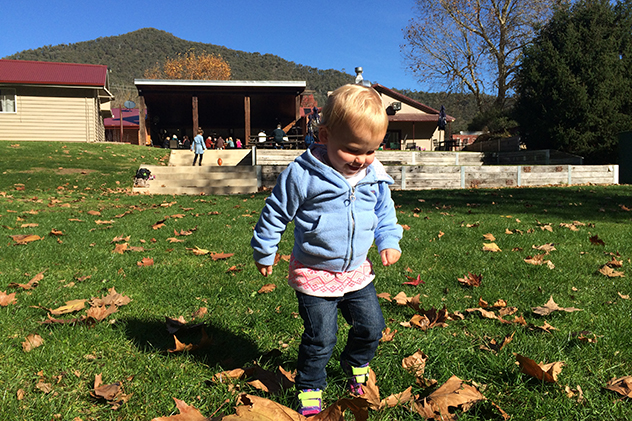
Mitta Mitta Pub on the Omeo Hwy, Mitta Mitta, Victoria.
From Mitta Mitta you can wind your way up to Albury and head home, or if you’re keen to extend your trip, turn it into a loop and return via a delightful chain of country towns – Beechworth, Myrtleford and Bright all offer the sort of bucolic beauty that Victoria does better than any other state.
The Murray Valley Highway roughly follows the tribulations of the Murray River as it makes its way along the NSW/Victoria border, and it seems purpose-built for an interesting road trip. It’s also the perfect option for a fly-drive, as most metro airports offer flights into Albury. Because many towns on this route are twin towns, it rewards road-trippers who can take their time.
Not far out of Albury/Wodonga are the Wonga Wetlands. This collection of mostly man-made lagoons and billabongs was an attempt to redress the ecological effects of the Hume Dam, which prevents the Murray River from flooding as it would naturally. The wetlands are a haven for ‘twitchers’, with egrets, cormorants, pelicans, spoonbills, ducks, and the iridescent blue flash of a kingfisher all likely sights.
A good way to sample border-life eccentricity is with a Lake Mulwala cruise on the Paradise Queen. On the Victorian side (Yarrawonga) it’s public land right down to the lake’s edge. On the NSW side (Mulwala), you can own land and water 30 metres into the lake. That’s reflected in lakeside property values – NSW homes routinely go for twice the price of their Victorian counterparts.

Lake Mulwala, a man-made reservoir located between Bundalong and Yarrawonga, Victoria.
The Yarrawonga-Mulwala Bridge over the Murray River further proves border life isn’t always harmonious. When you traverse the bridge, it has a dip and a kink in it. Why? Back in the day, the respective councils agreed to co-fund the bridge, and they were a fair way into construction when it became clear the bridge halves were different heights and headed in different directions…
Grouping the region between Yarrawonga and Echuca as the ‘Farm Gate Trail’ was a stroke of genius. Tiny primary producers that would normally escape attention are laid out on a handy map, available online an at most information centres. They offer wine, olives, cheese, fruit, chocolates, and… cacti. Cactus Country at Strathmerton is an ever-expanding botanical garden that plays host to cactus species from around the world. Fans of western movies can have their photo taken with one of those enormous South American cacti that seem to have arms.
If there’s a quintessential Victorian country town, it’s probably Echuca. Once Australia’s biggest inland port during the age of paddle steamers, it’s now a yardstick for tasteful modernisation. You’ll want a full day here to absorb its rustic charm, local produce (including some of the best port wines in the country), arcades, restaurants, walks and activities. You can even cruise the Murray River on the same sort of wood-fired paddle steamers active when the Port of Echuca was built in 1865.
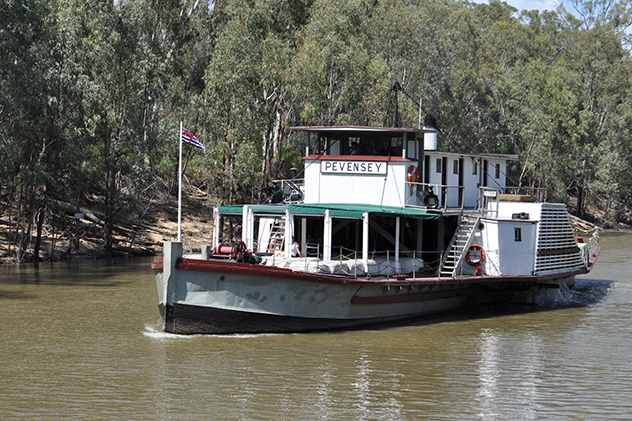
PS Pevensey Paddlesteamer on the Murray River, Victoria.
The Murray Valley Highway officially ends at Robinvale, but you owe it to yourself to continue along the Sturt Highway to Mildura and Wentworth. Mildura is the gateway to the outback and home to superb food and wines, while Wentworth is notable for the confluence of the Murray and Darling Rivers, which you can view from a purpose-built tower.
Not every memorable road trip has to be epic in scale. Phillip Island is a sort of microcosm, offering many of Victoria’s most appealing aspects in a compact and easily navigable area. It’s less than two hours from Melbourne, making it a feasible fly-drive road trip for interstate visitors. Best of all, you can explore it all from the NRMA Phillip Island Beachfront Holiday Park – we recommend one of its glamping safari tents, which have a sea view, electric fireplace, four-poster bed, lounge area, outdoor bath and gas barbecue.
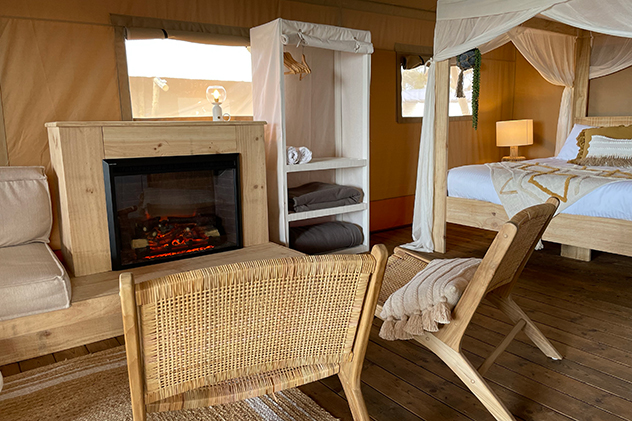
Safari Tent at NRMA Phillip Island Beachfront Holiday Park.
If you’re travelling with kids, be sure to set aside time for the A Maze N Things theme park. It comprises putt-putt golf links, a climbing course, the eponymous maze, and an apparently endless indoor labyrinth of puzzles, optical illusions and magic. Tickets don’t come cheap, but there’s everything from a time machine and a house of horrors to a vertical slide and interactive puzzles. It’s an excellent option for a rainy day – but try to go early or on a weekday, as it can get congested.
Another good wet weather option is the Phillip Island Chocolate Factory tour. The early stages are interactive – kids can feel a cacao pod, separate the beans, extract the oil etc – but rather dry and informative. Continue on, however, and it becomes more like a tour of Willy Wonka’s factory without the ruthless moral lessons and Oompa Loompas. You and some friends can climb aboard a scale to see if you’re heavy enough to offset a one-tonne block of chocolate, a robotic penguin will fetch you the chocolate coin of your choice (white, milk or dark), and you can operate a machine to create a chocolate pattern, which then cools on a conveyor belt and drops out at the end for you to eat. There’s even a machine replete with levers and buttons, that lets you create a mini chocolate block your preferred specifications, wrapped and everything. Phillip Island Chocolate Factory is every child’s fantasy of a chocolate factory made real.
The Purple Hen Winery in Rhyll is named after the purple swamphens that frequent the island (you’ll likely encounter a few on the winery’s access road) and it has views over nearby farmland and the bay on Phillip Island’s eastern side. Adults can enjoy a wine tasting in the dappled shade of a tree while the kids get to know winery terrier, Chip.
If you’re looking for lunch during your trip, cross the bridge onto Churchill Island. Here you’ll discover gorgeous highland cattle and a café with a rustic menu and coffee so good you’ll be sad to finish it. Kids will love the gift shop and history buffs will get ensconced in the information boards, which tell a detailed multi-generational story of Churchill Island’s inhabitants.
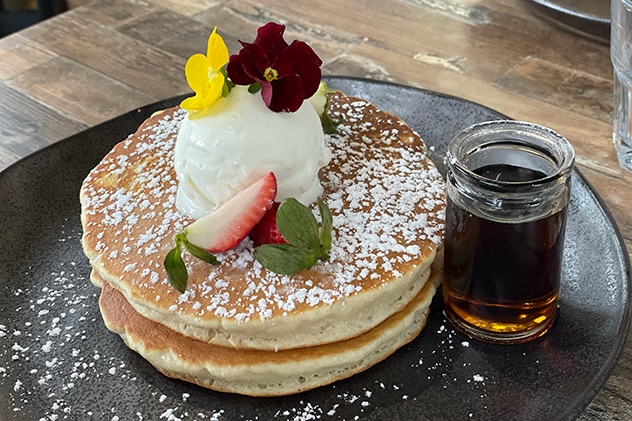
Fluffy pancakes at Churchill Island Heritage Park Cafe, Churchill Island, Victoria.
On the island’s south-west corner are the Nobbies. These rock formations, one of the last pieces of dry land before the watery expanse of Bass Strait, stand weather-beaten and lonely just off the point. A boardwalk traces the coast’s rugged majesty and cuts through foliage-carpeted hillsides – if you’re lucky you might spy a penguin in its burrow only a few metres off the path.
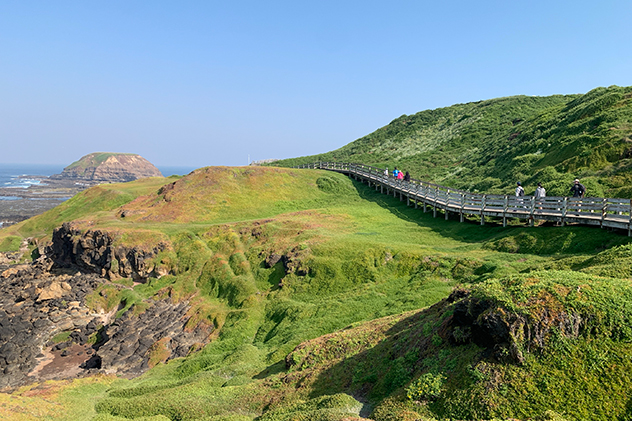
The Nobbies Walk, Phillip Island, Victoria.
The world long ago got wind of Phillip Island’s nightly penguin migration from the sea to its hillsides, and the Penguin Parade facilities have been upgraded accordingly. These days there is a sprawling carpark, a foyer with two theatre-style bars, a gift shop with four or five staff on registers, and a dozen turnstiles for checking tickets. Limiting nightly numbers is simply essential – this little island pocket would be overwhelmed if it were subject to a tourist free-for-all.
Arrive more than an hour before the penguins are due to emerge if you want anything resembling a good spot. Around dusk they return from a day’s fishing, occasionally alone but mainly in groups of five or ten. They make their way up the beach and horseshoe around the centre seating section to disappear into the island’s low, dense foliage. Once the penguin hordes have returned from the sea, you can spread out along the boardwalk (which has footlights) and get an eyeful of these adorable creatures going about their noisy, waddling business.
The central hub of Phillip Island is the town of Cowes. It offers an unexpected number of quality restaurants and cafés (Pino’s Trattoria on Thompson Avenue offers authentic Italian cuisine and atmosphere), but if you’re travelling with children make a beeline for the North Pier Hotel and its gigantic, kid-pleasing second floor with jumping castles and other inflatables, plus an air hockey table and a movie room.